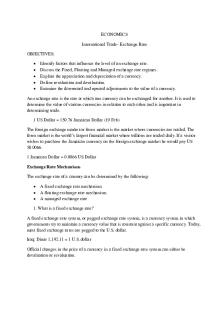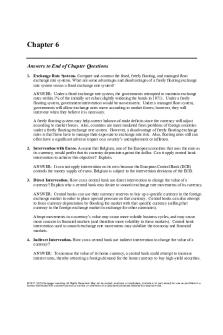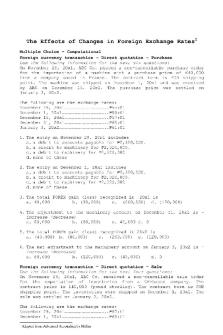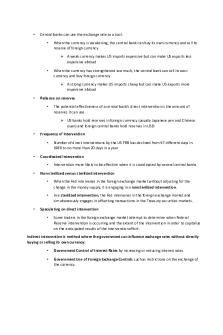Inflation, Exchange & Interest Rates PDF

| Title | Inflation, Exchange & Interest Rates |
|---|---|
| Course | Intl Financial Management |
| Institution | University College Dublin |
| Pages | 14 |
| File Size | 942.1 KB |
| File Type | |
| Total Downloads | 89 |
| Total Views | 187 |
Summary
Complete Summary and Notes on the topic of Inflation, Exchange & Interest Rates
Lecturer - Dr Vassilios Papavassiliou...
Description
Week 8 - Relationships among inflation, interest rates and exchange rates Chapter objectives -
Explain the purchasing power parity (PPP) theory and its implications for exchange rate changes Explain the International Fisher effect (IFE) theory and its implications for exchange rate changes Compare the PPP theory, the IFE theory, and the theory of interest rate parity (IRP), which was introduced in the previous chapter
Purchasing Power Parity (PPP) -
-
Interpretations of Purchasing Power Parity Absolute Form of PPP: without international barriers, consumers shift their demand to wherever prices are lower. Prices of the same basket of products in two different countries should be equal when measured in common currency Relative Form of PPP: Due to market imperfections, prices of the same basket of products in different countries will not necessarily be the same, but the rate of change in prices should be similar when measured in common currency
Example -
-
-
Assume that US experiences a 9% inflation rate while the UK experiences a 5% inflation rate. PPP suggests that the pound should appreciate by 4% (the difference between their inflation rates) Given British inflation of 5% and the pound’s appreciation of 4%, US consumers will have to pay about 9% more for British goods than they paid initially. That value is equal to the 9% increase in prices of US goods due to inflation The exchange rate should adjust to offset the differential in their inflation rates, in which case the prices of goods in the two countries should appear similar to consumers
Rational Behind Relative PPP Theory -
Exchange rate adjustment is necessary for the relative purchasing power to be the same whether buying products locally or from another country If the purchasing power is not equal, consumers will shift purchases to wherever products are cheaper until the purchasing power is equal
A second example -
-
-
Reconsider the previous example but now suppose that the pound appreciated by only 1% in response to the inflation differential. The increased price of British goods to US consumers will be approx. 6%if then ef will be positive and the foreign currency will appreciate. This appreciation will make returns on foreign securities similar to home security returns If ih...
Similar Free PDFs

Inflation, Exchange & Interest Rates
- 14 Pages

Exchange Rates - economics notes
- 4 Pages

Interest rates and bond pricing
- 4 Pages

06 Interest Rates & Bond Valuation
- 46 Pages

Chapter 7, interest rates and bonds
- 15 Pages
Popular Institutions
- Tinajero National High School - Annex
- Politeknik Caltex Riau
- Yokohama City University
- SGT University
- University of Al-Qadisiyah
- Divine Word College of Vigan
- Techniek College Rotterdam
- Universidade de Santiago
- Universiti Teknologi MARA Cawangan Johor Kampus Pasir Gudang
- Poltekkes Kemenkes Yogyakarta
- Baguio City National High School
- Colegio san marcos
- preparatoria uno
- Centro de Bachillerato Tecnológico Industrial y de Servicios No. 107
- Dalian Maritime University
- Quang Trung Secondary School
- Colegio Tecnológico en Informática
- Corporación Regional de Educación Superior
- Grupo CEDVA
- Dar Al Uloom University
- Centro de Estudios Preuniversitarios de la Universidad Nacional de Ingeniería
- 上智大学
- Aakash International School, Nuna Majara
- San Felipe Neri Catholic School
- Kang Chiao International School - New Taipei City
- Misamis Occidental National High School
- Institución Educativa Escuela Normal Juan Ladrilleros
- Kolehiyo ng Pantukan
- Batanes State College
- Instituto Continental
- Sekolah Menengah Kejuruan Kesehatan Kaltara (Tarakan)
- Colegio de La Inmaculada Concepcion - Cebu










